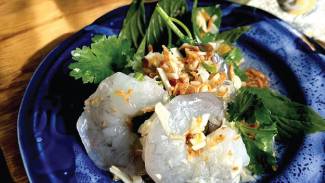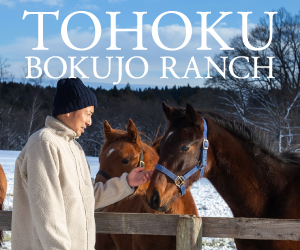SHOKUNIN SHOYU
SPREADING THE WORD
120 FLAVOR OPTIONS FROM ACROSS JAPAN
Staff offers advice on soy sauce attributes as well as recommendations for optimal food pairings
Soy sauce is the essential seasoning in Japanese cuisine. While soy sauce is known around the world, few have heard of a specialty shop selling around 120 varieties from across Japan. That shop is Shokunin Shoyu, which roughly translates as “Artisans of Shoyu.” The shop is in Maebashi, Gunma Prefecture, and has an online store as well.
“Shoyu is not a commodity,” said Shokunin Shoyu’s owner Mantaro Takahashi, using the term for Japanese soy sauce. “It is its own genre, within which there is a diversity of characteristics.”
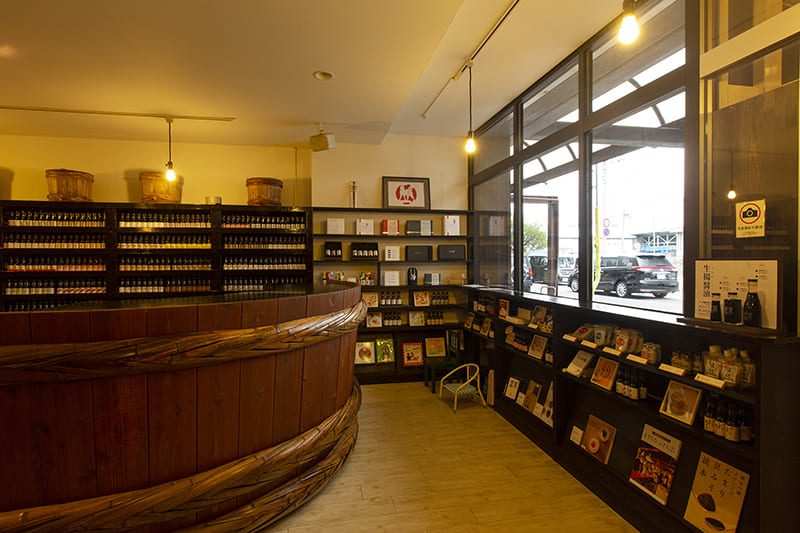
SHOKUNIN SHOYU
Takahashi has been all over Japan, collecting information on hundreds of shoyu breweries firsthand. He has tasted sauces, listened to brewers and their stories and selected their finest products for sale in his shop. This is the Shokunin Shoyu concept.
“Shoyu that has been crafted by artisans with strong convictions and is rooted in a concept that can be put into words, is going to be delicious,” Takahashi said.
Takahashi would never have guessed that his life would one day revolve around Japanese soy sauce. In 2006, after a career selling precision optical equipment for a major maker of automation equipment, he quit his job and traveled all over Japan, developing an interest in traditional industries. Soy sauce in particular fascinated him. He started making trips to breweries around the Kanto region, and the more he spoke to brewers, the more his interest was piqued.
Takahashi had always viewed soy sauce as just sauce, but he discovered that there are many distinct types, with various brewers using different ingredients and methods within the same type. Some use high-tech equipment while others stick to traditional wooden barrels. In the world of shoyu, diversity prevails.
Tasting sets invite exploration
One day, Takahashi was visiting a major department store. As he stared at the shelves crowded with a multitude of choices, he was shocked to discover that his hard-won shoyu knowledge, which made him an expert, was of no help when it came to selecting one for a specific use. Moreover, buying multiple liter-size bottles simply for tasting purposes wasn’t going to work. It was in that moment that the idea of selling soy sauce in 100-milliliter bottles dawned on him.

SHOKUNIN SHOYU
Takahashi went back to several breweries to pitch his idea, but they were doubtful that consumers would buy such tiny bottles. Eight brewers finally agreed to come on board, but the resulting lineup of eight sauces in small bottles somehow lacked impact. Takahashi decided he would have to astonish customers with an extensive choice. So he expanded his search to promote his 100-ml bottle concept nationwide and ended up visiting more than 400 breweries.
Shokunin Shoyu currently offers around 120 varieties of shoyu from 60 breweries. Despite the extensive selection, customers who visit need not feel overwhelmed. Knowledgeable staff are on hand to guide them, recommending varieties that match preferences with specific uses. The website also offers abundant information on how Japanese soy sauce is made, the types available and how to choose one. For newcomers, Takahashi has assembled a balanced starter set that features six varieties.
All bottles are the same size and shape, with each producer handling the filling and labeling. “Labels are reduced in size, but otherwise they’re as close to the brewer’s full-size label as possible,” Takahashi noted.
With such a variety of products on offer, Shokunin Shoyu can showcase the condiment’s rich diversity of color, aroma and umami notes. Japanese soy sauce is especially known for its exceptional bouquet, Takahashi said. He explained that soybeans primarily contribute umami and wheat adds fragrance, but the uniqueness of the condiment lies in the balance achieved between the two, a balance that discretely brings out the flavor contributions of dashi and the individual ingredients in delicate Japanese cuisine.
Takahashi uses a chart to make his point. The chart shows six pieces of sushi, each placed against a different background color. “The color of each background is actually the color of the shoyu itself,” Takahashi explained.
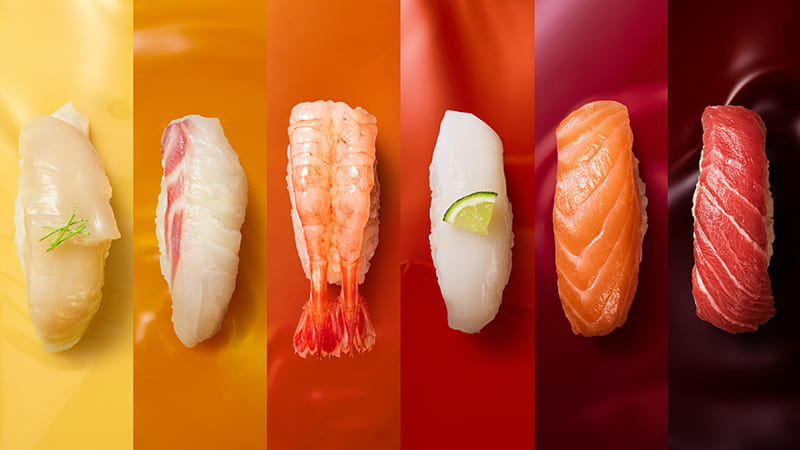
SHOKUNIN SHOYU
In other words, each piece of sushi pairs best with a certain type of sauce, from the light ones on the far left to the dark ones on the far right. Takahashi continued:
“The koikuchi (common) shoyu shown in the center is the most standard type. The shiro (pale) and usukuchi (light-colored) on the left are lighter but saltier, with an umami that is restrained. The tamari (full-bodied) on the right has been aged for a long time. It has dark color and strong umami flavor.”
In Japan, there are five categories of soy sauce, according to the Agriculture Ministry. But Shokunin Shoyu is unique in using its own six-category system. Takahashi counts amakuchi shoyu, which is a sweet variety of koikuchi popular in the Kyushu region, as the sixth category.
Takahashi compared soy sauce with wine to explain the categories.
“Soy sauce categories resemble the categories used to classify wine. It’s easier to picture if we think of the three types of soy sauce shown on the left side of the chart as white wines, and the three on the right as red wines. So, for example, a meuniere or carpaccio of white-fleshed fish would pair best with a white wine. A steak would usually be paired with a red wine. These sorts of relationships apply to soy sauce as well.”
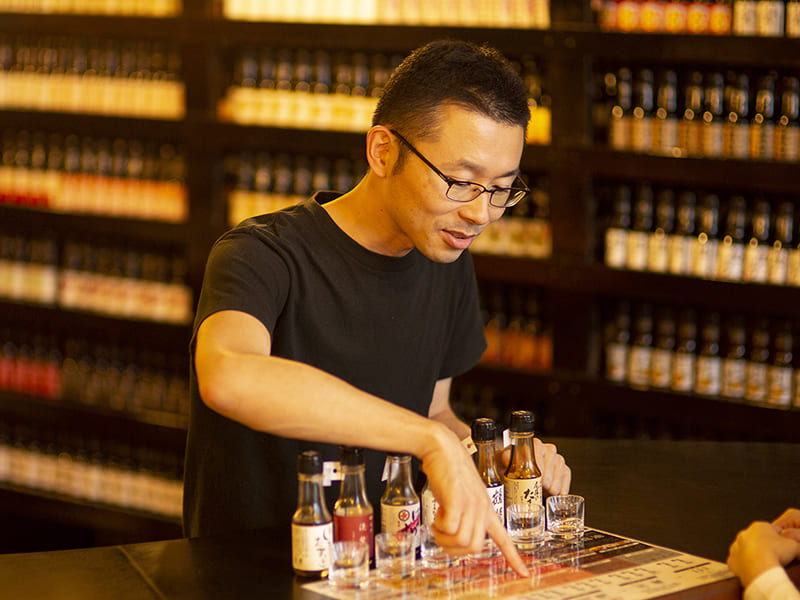
SHOKUNIN SHOYU
As the sushi chart shows, the fish used ranges from light-flavored, white-fleshed types to fatty, red-fleshed ones. Matching soy sauces to fish types does much to bring out their respective flavors. Similarly for salads, simply mixing soy sauce with olive oil and vinegar creates a fresh dressing that enhances the natural taste of the vegetables, Takahashi said.
Importance of fermentation
Takahashi emphasized the importance of understanding that soy sauce is a fermented food. It is precisely because the ingredients undergo long-term fermentation through the power of microorganisms that each brewery can produce a unique sauce. He cited shoyu brewed traditionally in wooden barrels as a prime example.
“In a natural environment, raw ingredients placed in wooden barrels undergo years of fermentation and aging by the microorganisms living in the brewery and in the barrels themselves. Ultimately, aging is everything. Since each barrel imparts a different character, the unique traits of each brewery emerge in the shoyu, fully distinct. The brewer’s personality and philosophy can be found there as well.”
Takahashi pointed out the similarities between soy sauce and products like balsamic vinegar and wine. Seen in this light, it is easier to understand the diversity of soy sauce and how its use can vary depending on specific dishes or personal preference.
He recommends brewery tours as a way to experience this diversity firsthand. There are breweries all over Japan that welcome visitors and can provide an experience as rewarding as visiting a winery.
“To make your favorite foods even more delicious, why not search out the best-matching soy sauce?” Takahashi suggested.
Soy sauce has evolved along with regional food cultures, adapting to the climate, ingredients and customs of each. As such, there are as many varieties of shoyu as there are culinary traditions. The lineup of 100-ml bottles at Shokunin Shoyu could very well spark a fascination that leads to the world of artisanal soy sauce.
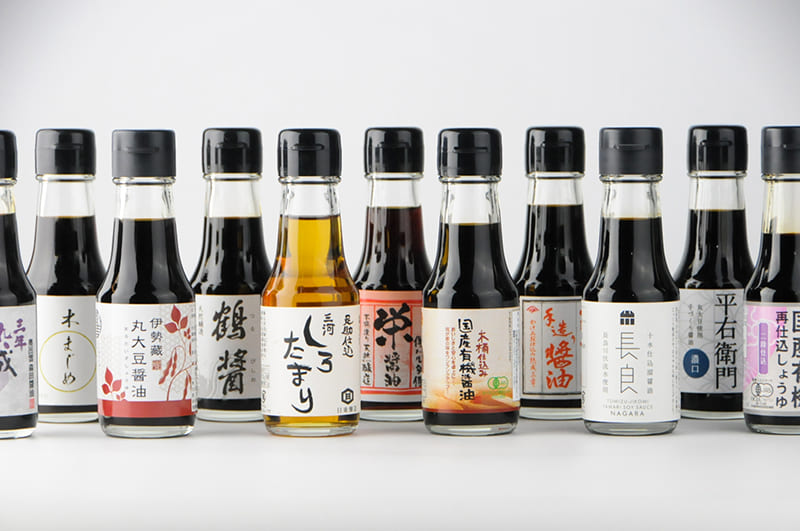
SHOKUNIN SHOYU
SHOKUNIN SHOYU: https://store.s-shoyu.com/en



